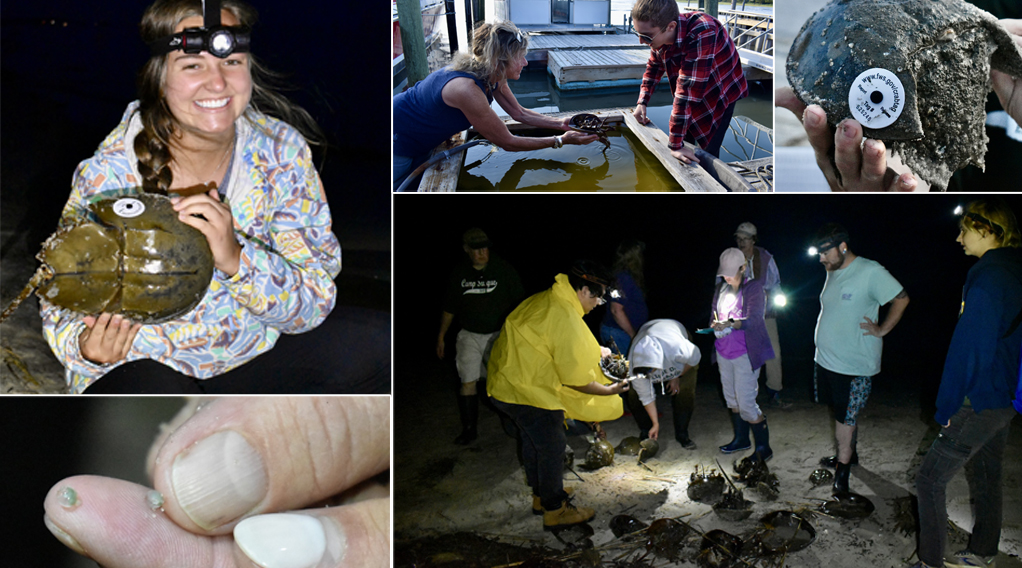CSM Travel Study Students Put Education into Action to Aid Horseshoe Crab Conservation Efforts

“The fact that their lineage is so ancient, and their biology differs so dramatically from humans makes them seem almost alien.”
 It’s a cycle that has existed each spring for millions of years: as dusk falls along the Delaware Bay, thousands of horseshoe crabs come ashore to lay their eggs, which then become food for migrating birds. Scientists are still working to fully understand the threads of this complex web, but on a night this past May they had help from College of Southern Maryland (CSM) students and faculty members, who traveled to Cape May, New Jersey to help tag the “living fossils” for scientific research.
It’s a cycle that has existed each spring for millions of years: as dusk falls along the Delaware Bay, thousands of horseshoe crabs come ashore to lay their eggs, which then become food for migrating birds. Scientists are still working to fully understand the threads of this complex web, but on a night this past May they had help from College of Southern Maryland (CSM) students and faculty members, who traveled to Cape May, New Jersey to help tag the “living fossils” for scientific research.
The trip was part of CSM’s travel study program, which gives students the opportunity to go beyond the classroom and put their education into action. According to CSM Dean of Learning Resources Dr. Stephanie McCaslin, this particular trip was a great opportunity for students to play a role in the “ecological domino effect” of environmental protection efforts while learning about the horseshoe crabs' migratory patterns in ways that help conservationists understand the prehistoric species.
“They were really making those connections and applications to everything they were learning at CSM, from environmental diversity to statistics,” said McCaslin.
Although some students were initially nervous about hurting the crabs, McCaslin said they soon got over their apprehension and tagged hundreds of the spiny arthropods, even jokingly giving each one a name before setting it free. The data that will come from this tagging effort will help scientists at the American Littoral Society and their partners to plan their actions, including sand placement and reef creation to protect horseshoe crab spawning habitats and shorebird foraging grounds.
“Tagging the crabs felt fulfilling,” shared CSM Biology student Eyron Tapia-Sibri. “I’m thankful I got a chance to help these ancient yet helpful creatures. Seeing the horseshoe crab eggs was especially interesting. It always amazes me when living creatures come from something so small. As valuable as it is to learn in a classroom, being able to interact and see it in action will always be helpful.”
“I find horseshoe crabs to be a fascinating species of arthropods,” agreed Engineering student Kaleb Bennett. “The fact that their lineage is so ancient, and their biology differs so dramatically from humans makes them seem almost alien.”
In addition to tagging the crabs, the students learned about the local ecosystem through hikes and boat tours, where they saw shorebirds and dolphins, and visited area landmarks and museums. McCaslin said that faculty even worked with students to ensure that they included activities that aligned with their individual interests.
“I felt that CSM made it very easy for me to participate,” said Environmental Science student Kyle Jenks. “They made sure that all of us were comfortable and worked with us to plan daily activities before we went to the beach for horseshoe crab tagging.”
In addition to being a CSM student, Jenks volunteers at Calvert Marine Museum as an aquarist assistant and said that the trip was a natural fit for his goals to eventually work with marine life as a biologist. McCaslin agreed that travel experiences are valuable additions to students’ resumes.
“Our faculty members know how much students get out of these hands-on adventures and think about ways they can invigorate the students and get them out of the area for these experiential learning programs,” she said.
Thanks to funding provided through the National Science Foundation, S-STEM scholars like Tapia-Sibri, Bennett, and Jenks were able to attend the Cape May trip at no cost to them.
This horseshoe crab tagging trip was proposed by CSM Biology Professor Tracey Stuller, who joined the American Littoral Society on a similar tagging trip last year and immediately saw its potential as a learning activity for students.
The trip to Cape May was one of the first new travel study opportunities that CSM has provided since the COVID-19 pandemic abruptly cancelled all trips in 2020. Janet Thompson, who helps to coordinate travel study for CSM’s Division of Learning, said that since then, students, parents, and faculty comfort levels with travel have changed, and the department is adjusting its offerings in response. According to Thompson, the Cape May trip is an example of the local travel opportunities that CSM hopes to increasingly provide to students.
Whether they travel up the coast or across the ocean, Thompson emphasized that the opportunity to leave Southern Maryland and get hands on experience is invaluable for students.
“There's a whole world and a lot of places to see and things to do,” she said. "There’s something about traveling with a group of your peers that's more than just a field trip. It's an opportunity that you chose to take advantage of, and it opens a lot of doors.”
To view photographs of the CSM Travel Study S-STEM horseshoe crab tagging trip, visit https://csmphoto.zenfolio.com/p300680674.
 my.CSMD
my.CSMD